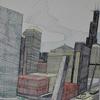Bonhams & Butterfields to Offer Hans Stuck’s Legendary Auto Union Grand Prix Racer at Quail Lodge in August
- CARMEL, California
- /
- July 28, 2009
Bonhams & Butterfields is delighted to offer for sale by auction nothing less than one of the most charismatic Grand Prix racing cars ever built – the 1939 Auto Union ‘D-Type’ with rear-mounted 3-liter twin-stage supercharged V12-cylinder engine. The annual collector’s motorcar car auction is set for August 14, 2009 in Carmel, CA.
This legendary racing car - absolutely confirmed today as chassis number ‘19’ - was driven to placing finishes in the 1939 Grand Prix racing season. Handled by Auto Union factory team drivers Rudolf Hasse and Hans Stuck, this pioneering rear-engined Grand Prix projectile finished fifth in the German EifelRennen event on the North Circuit of the Nurburgring, and sixth in the Grand Prix de l’Automobile Club de France around the super fast public road course at Reims-Gueux.
The 1938-39 V12-cylinder Auto Union racing car – retrospectively classified postwar as the Chemnitz company’s ‘D-Type’ model – was developed to meet a new set of international regulations governing Grand Prix racing. They specified a maximum engine capacity of 3-liters and a minimum weight limit of 850-kilograms. The ‘D-Type’ Auto Union was based upon a highly sophisticated and advanced new chassis design, featuring de Dion rear suspension and its fuel load centralized in pannier tanks hung along each side, within the wheelbase. The 3-cam V12-cylinder engine developed some 420bhp in 1938 single-stage supercharged form, rising to some 485bhp at 7,000rpm when two-stage supercharging was adopted for 1939.
That final pre-war season – whose leading cars such as this Auto Union represent the absolute high-tide of ‘Silver Arrows’ period technology - then opened on May 21 with the EifelRennen, at Germany’s Nurburgring, where Nuvolari’s ‘D-Type’ finished second and Rudi Hasse fifth in chassis ‘19’ now being offered by Bonhams & Butterfields.
During the 1939 racing season, Auto Union deployed 11 ‘D-Type’ chassis in the six significant Grand Prix Formula events contested. In addition to Nuvolari’s second place in the EifelRennen, Hasse finished second in the Belgian GP, before his team-mates H.P. ‘Happy’ Muller and ‘Schorsch’ Meier brought the team a wonderful 1-2 success in the French race at Reims-Gueux.
It was there that chassis ‘19’ raced for the last time, driven by Hans Stuck, the veteran Austrian star. In his hands, this ‘D-Type’ Auto Union completed the works team’s day by finishing sixth.
Today, Auto Union ‘D-Type’ chassis ‘19’ is the only proven surviving Grand Prix car of its type with contemporary 1939 racing history. It is one of the classic car world’s most charismatic machines, and is exquisitely well-restored to running order. In a world hungry for genuine intrinsic value, it has much to commend it.
Post-war Myth and Mystery
For nearly half a century the survival in Communist Russia of ex-works German ‘Silver Arrow’ Grand Prix cars from the 1930s seemed little more than unproven myth. The search for any such cars from Mercedes-Benz or – much more so – Auto Union - was regarded as historic motor sport’s quest for the Holy Grail. While several 1930s Mercedes-Benz Grand Prix cars survived at the Stuttgart factory and in private Western hands, the only known Auto Union was a sectioned 1936 V16 model exhibited in the Deutsches Museum in Munich.
It was known that the surviving Auto Union team cars had been expropriated by Soviet forces in the Autumn of 1945. In fact, no fewer than 13 Auto Union cars were transported by train from the company’s devastated factories in Zwickau and Chemnitz, Lower Saxony, in what was to become Communist East Germany.
They were delivered to the Soviet Union’s NAMI motor industry research institute in Moscow, where early in 1946 a working group of engineers was established to investigate these dazzlingly high-tech German designs. Four Auto Unions - one with wheel-enveloping streamlined bodywork – were dismantled and effectively destroyed during the NAMI group’s inspection and analysis.
Two sister cars were delivered to Moscow’s ZIS production car factory for parallel examination and research. One, a V16-cylinder, was subsequently scrapped. The other - which was a hill-climb car comprising a 16-cylinder-type chassis powered by the later V12 engine - escaped destruction, eventually passing into a museum in Riga, Latvia, and subsequently to Audi.
Four other Auto Unions - three 1938-39 V12 Grand Prix cars, plus one streamliner - went to the GAS factory in Gorky (now renamed Nizhniy Novgorod) where some components were cannibalized for use in GAS, Moskvich and ZIL-based competition cars. When one staffer required a trailer, a stripped Grand Prix chassis frame was cut in half to suit…!
Generally, the Soviet technicians were unable to run the cars, with the exception of one V12 ‘D-Type’ at Gorky, whose tanks were found to contain the correct sophisticated German fuel mix. This car was started successfully and tested at high speed, only for driver Leonid Sokolov to find his path obstructed by encroaching roadside crowds. He lost control under braking, and crashed into them, killing as many as 18.
Around 1950, two surviving open-wheel GP Auto Unions and one 16-cylinder streamliner were assigned to engineer Vladimir Nikitin in Kharkov, Ukraine. He cannibalized the streamliner to build his ‘Kharkov’ racing car, powered by a 4-cylinder Podeba street engine. A fellow Ukrainian engineer, Eduard Lorent, also benefited from Auto Union study in building his small- capacity ‘Kharkov L1’ and ‘L2’ racing cars.
One complete open-wheeler chassis, the trailer-frame and their major mechanical components survived surplus to Nikitin and Lorent’s requirements, and after the collapse of the Soviet Union, Russian-born American Paul Karassik – a Florida-based antique car enthusiast – spent much time in Russia hunting down the truth of the Auto Union legend. Karassik accumulated an incredible treasure-trove of pre-war Grand Prix car components, including Auto Union serial ‘19’s complete, unspoiled chassis and the late-model V12-cylinder engine which powers it today. Mr Karassik entrusted restoration of this car to the renowned British ‘Silver Arrow’ specialists, Crosthwaite & Gardiner in Buxted, England, and they rebuilt it in as-original two-stage supercharged form.
Seventy years later, Auto Union ‘D-Type’ chassis ‘19’ will star in the Bonhams & Butterfields sale at Quail Lodge in California on August 14, when it is expected to realize in excess of $8-million. It represents a uniquely attractive investment in cutting-edge history, and will likely provide a new owner with a unique and enduring entry ticket to every one of the classic car world’s most prestigious events.
Bonhams Quail Lodge auction is now in its 12th year, and regularly attracts the world’s finest collector cars for sale, last year’s auction totaled more than $21-million, and recorded four world record prices.
Bonhams & Butterfields will present its illustrated auction catalog online in the weeks preceding the August sale at www.bonhams.com/quail, and consignments are invited. For more information on Motoring sales at Bonhams & Butterfields, please visit: www.bonhams.com/motors
http://www.bonhams.com
About Bonhams
Bonhams, founded in 1793, is one of the world's oldest and largest auctioneers of fine art and antiques. The present company was formed by the merger in November 2001 of Bonhams & Brooks and Phillips Son and Neale UK. In August 2002, the company acquired Butterfields, the principal firm of auctioneers on the West Coast of America and in August 2003, Goodmans, a leading Australian fine art and antiques auctioneer with salerooms in Sydney, joined the Bonhams Group of Companies. Today, Bonhams offers more sales than any of its rivals, through two major salerooms in London: New Bond Street, and Knightsbridge, and a further seven throughout the UK. Sales are also held in San Francisco, Los Angeles, New York and Boston in the USA; and Switzerland, France, Monaco, Australia, Hong Kong and Dubai. Bonhams has a worldwide network of offices and regional representatives in 25 countries offering sales advice and valuation services in 57 specialist areas. For a full listing of upcoming sales, plus details of Bonhams specialist departments, go to www.bonhams.com. (01-08) For other press releases, go to www.bonhams.com/press.
















